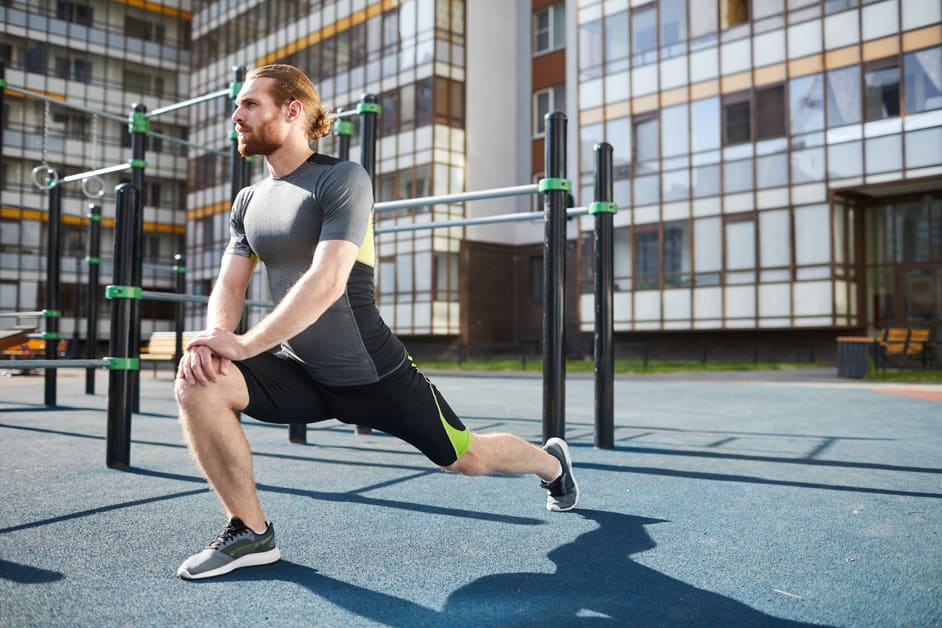Introduction
Dynamic stretching and static stretching are both beneficial. But which is better for knee health? It’s key to understand their differences.
Dynamic stretching boosts range of motion in joints and muscles, through movement. It increases elasticity and readies muscles for activity. Static stretching involves extending a muscle or muscle group to its max length and holding it there for 15-30 seconds or longer, to improve flexibility.
Dynamic stretching is widely accepted as helpful for physical activity. It activates multiple muscles and joints, mimicking exercise. It helps coordination, balance, agility and muscle memory.
Static stretching does not involve active movement. It takes certain muscles and pushes them through their range of motion, till tension is felt in the area. This gives greater flexibility and comfort during daily activities.
Stretching won’t prevent injury unless done correctly. Both dynamic and static stretches should be done regularly, to keep limber and mobile without pain during physical activities. Dynamic stretches help performance, while static stretches help recovery and reduce post-exercise soreness.
What is Dynamic and Static Stretching?
Dynamic stretching is a movement-based technique. On the other hand, static stretching is a held and lengthened position based one. Both types of stretching have great benefits for knee health. They can help with increasing flexibility and range of motion in the joints.
Let’s look more closely at dynamic and static stretching. And find out which type of stretching is best for knee health.
Benefits of Dynamic Stretching
Dynamic stretching is a type of stretching that involves movement. You can increase reach, speed, or both. It’s good to do before physical activity. It can help with injury and performance. Athletes may do arm circles and shoulder presses. Or walking lunges with rotation.
Dynamic stretches can be beneficial for the knees. They target the muscles and increase range-of-motion. Blood flow and lubrication increase too. Plus, tension on the muscles and tendons decrease. And you lessen the chance of sudden force on the knees – which can cause injury or pain.
Benefits of Static Stretching
Static stretching is a type of stretching that involves holding a muscle in a position for 15-30 seconds. It increases the “give” of the muscle, which helps create a larger range of motion. This can help reduce stress on nearby muscles, tendons, and ligaments and reduce the chance of injury.
It also reduces tension during exercise, increases blood flow, and boosts energy levels. Plus, it can reduce the risk of back pain due to tight hamstrings and improve postural alignment.
These are just a few potential benefits of static stretching. Always consult your doctor or physical therapist before beginning an exercise program.
How Does Dynamic and Static Stretching Affect Knee Health?
Dynamic and static stretching are two different forms of stretching. Each has its own advantages and disadvantages for knee health.
- Dynamic stretching involves controlled movement through a range of motion.
- Static stretching consists of holding a position for longer.
In this article, we’ll explore how both kinds of stretching affect knee health.
Dynamic Stretching and Knee Health
Dynamic stretching is a great way to prepare for physical activity. It uses active stretches with rhythmic movements. This can be seen in warm-ups for sports, to increase awareness of how muscles move. It also reduces the risk of injury.
Dynamic stretching needs more concentration than static stretching. Proper form and coordination is key. For example, when running or jumping lunges, keep your chest up and take controlled steps with feet facing forward. This increases the temperature in your joints and may help circulation. Calf raises can also be modified according to difficulty levels. Lift onto toes, hold for a few seconds, then lower slowly as far as possible.
The benefits of dynamic stretching are:
- Improved knee health, including improved stability and flexibility, reducing wear and tear on joint structures.
- Reduced inflammation and swelling, leading to an earlier return from knee injuries and quicker recuperation time from exercises.
- Reduced fatigue compared to static stretches.
Static Stretching and Knee Health
Static stretching is a form of stretching in which an athlete holds a position of an extended muscle for a period of time. This can range from 15-60 seconds. The goal is to reduce tension and strain, as well as improve flexibility and range of motion.
It’s especially helpful post-workout for recovery. Studies have found it lowers post-exercise cortisol levels and is beneficial for knee health.
26 studies have looked at how motor activities, like walking or biking, can benefit knee OA patients. Research concluded that low impact physical activity and regular static stretches can help with OA symptoms without increasing cardiovascular risk factors.
Static stretching has become a key part of many exercise regiments, to promote increased comfort and improved knee health.
Conclusion
Dynamic stretching is great for pre-workout, static stretching for post-workout—both help with knee health. To maximize lower extremity protection and propulsion, see a pro to figure out which type of stretching is best for you. Dynamic stretching prior to any physical activity reduces the risk of joint injury. It does this by maintaining proper coordination during athletic movements. Static stretching afterwards helps with repair processes, circulation, flexibility and range-of-motion. And both dynamic and static stretching can play a role in injury prevention.
Use them alone or together as part of an overall fitness routine or sports specific program.
Frequently Asked Questions
Q1: What is the difference between dynamic and static stretching?
A1: Dynamic stretching involves slow, controlled movements that take your muscles through a full range of motion. Static stretching involves holding a position for a period of time to stretch a muscle.
Q2: Which type of stretching is better for knee health?
A2: Dynamic stretching is generally better for knee health as it increases flexibility and range of motion. Static stretching can be beneficial as well, but it is important to not overstretch and cause injury.
Q3: How often should I stretch to maintain knee health?
A3: It is recommended to stretch at least 2-3 times a week to maintain knee health. Be sure to listen to your body and not push yourself too hard.





